Welcome to the wonderful world of birds in Oakhurst! Nestled in the Sierra Nevada foothills of California lies the charming town of Oakhurst, home to some of the most diverse and beautiful birds in the world.
From the majestic golden eagles soaring over the craggy Sierra Nevadas to the delicate hummingbirds flitting among the wildflowers, Oakhurst’s avian population is sure to delight birdwatchers and nature enthusiasts alike.
With its wide range of habitats, including riparian woodlands, coniferous forests, and grasslands, Oakhurst is a paradise for birding.
Whether you’re looking to observe a flock of acrobatic turkey vultures or search for the elusive California condor, you’ll find plenty of opportunities to explore the local birdlife. So come and join us as we explore the fascinating birds of Oakhurst!.
1. Red-tailed Hawk
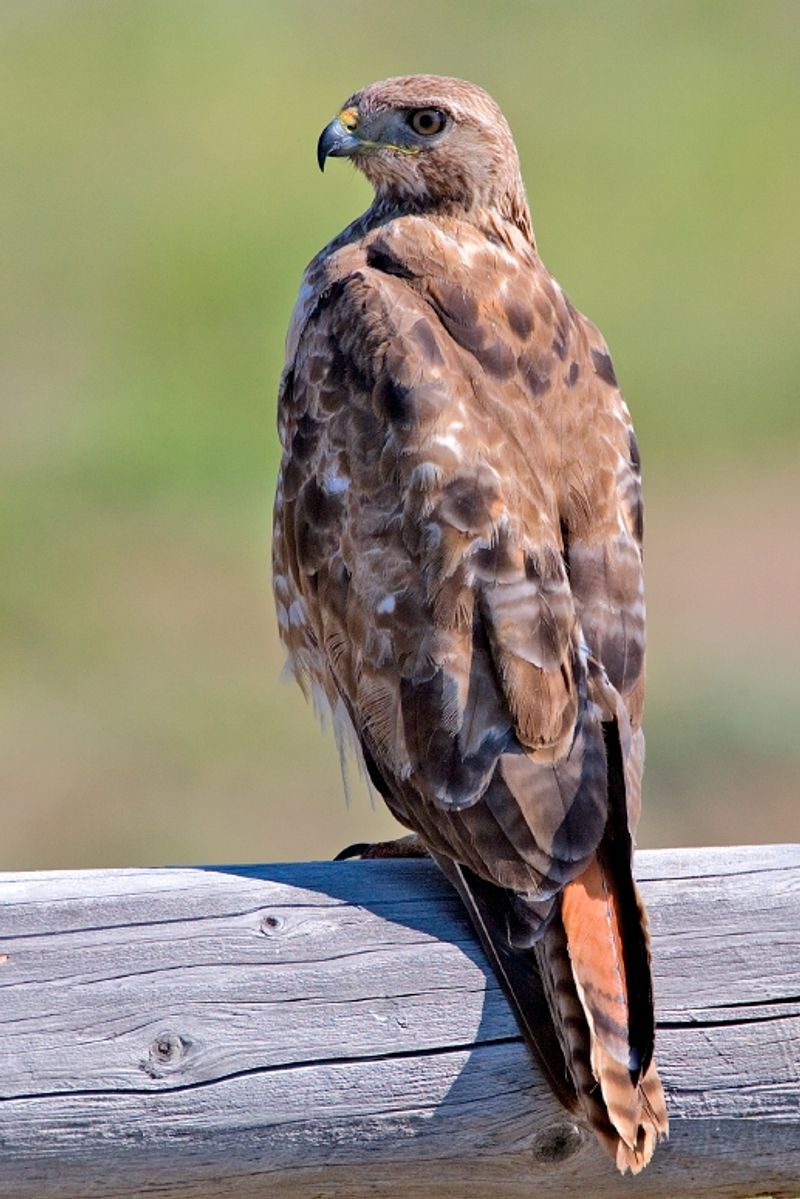
The red-tailed hawk is a bird of prey that is widely distributed throughout North America, from the northern regions of Alaska and Canada to the south of Panama and the West Indies.
This particular species is one of the most well-known members of the Buteo genus, not only in North America but also around the world. The red-tailed hawk can be identified by its distinctive red tail feathers, which contrast with its otherwise brownish-gray body.
This species of hawk generally prefers open areas, such as grasslands and woodlands, and can sometimes be seen soaring in the air searching for food. Its diet consists mainly of small mammals, reptiles, and insects, which it hunts by swooping down from the sky.
The red-tailed hawk is also known for its impressive vocalizations, which include a variety of loud, shrill cries and whistles. These birds also build large nests in tall trees, which can sometimes be seen high in the branches.
It is an impressive sight to behold, and its presence is often seen as a sign of good luck or prosperity in some cultures.
Overall, the red-tailed hawk is a majestic and resilient species, and its ability to thrive in a variety of environments throughout North America makes it a fascinating member of the Buteo genus.
| Kingdom | Animalia |
| Phylum | Chordata |
| Class | Aves |
| Order | Accipitriformes |
| Family | Accipitridae |
| Genus | Buteo |
| Species | B. jamaicensis |
2. Red-winged Blackbird
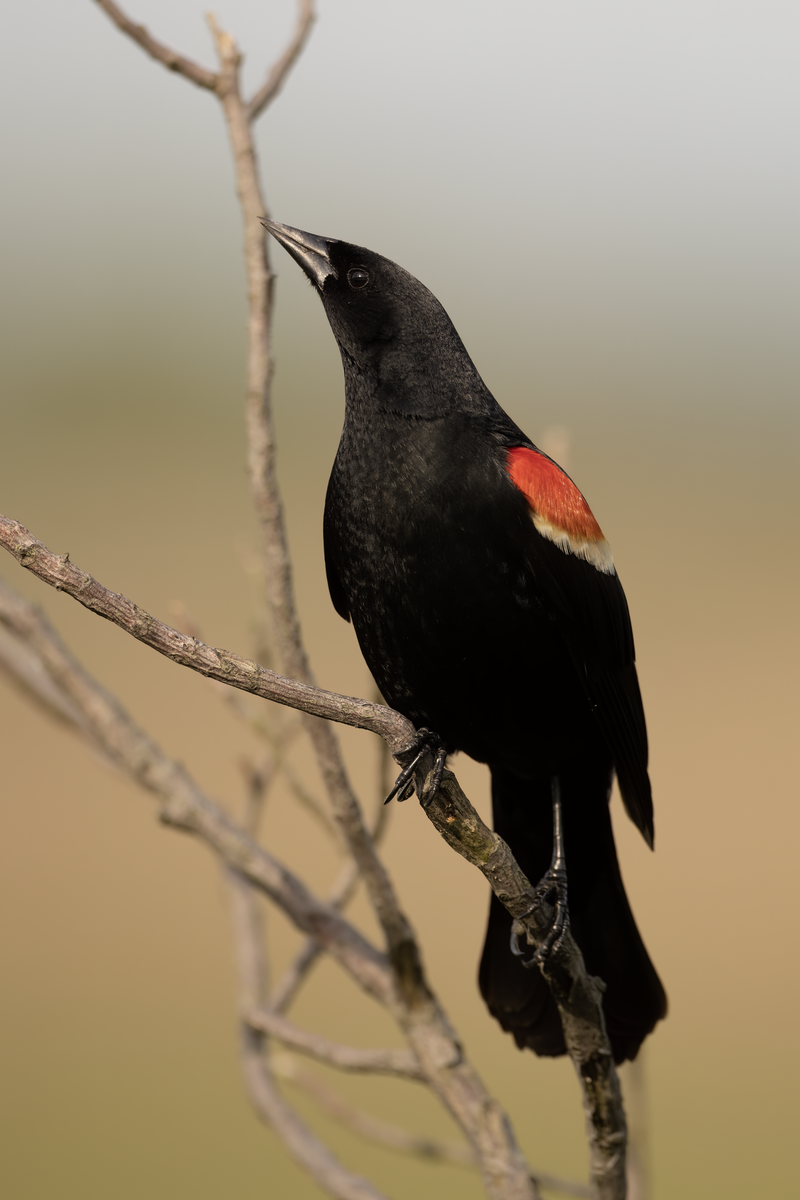
The red-winged blackbird is a member of the Icteridae family of birds, found throughout much of North America and Central America. These birds are one of the most abundant and wide-ranging passerines, or perching birds, in the world.
They are easily distinguished by their black body and red and yellow shoulder patches, which can be seen while they are in flight. Red-winged blackbirds are social birds, often found in large flocks. They prefer open, grassy areas and wetland habitats.
During the breeding season, they are typically found around marshes, ponds, and flooded fields. They are omnivorous, eating insects such as grasshoppers and caterpillars, as well as seeds, fruits, and grains.
The red-winged blackbird is an iconic species in North America, and their loud, melodious calls are a familiar sound to many.
These birds are important for their role in seed dispersal and insect control, and they are also an important food source for many predatory species, including hawks, owls, and crows.
| Kingdom | Animalia |
| Phylum | Chordata |
| Class | Aves |
| Order | Passeriformes |
| Family | Icteridae |
| Genus | Agelaius |
| Species | A. phoeniceus |
3. American Robin
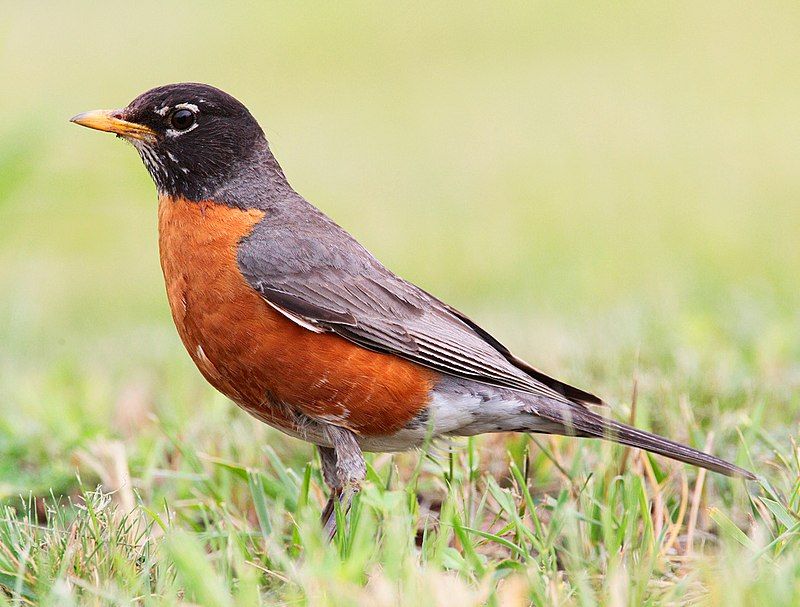
The American robin is a migratory bird that belongs to the true thrush genus and Turdidae family, commonly known as the thrush family. It is named after the European robin due to its reddish-orange breast.
However, the two species are not closely related, as the European robin is part of the Old World flycatcher family. The American robin is a songbird that can be found in many parts of the United States, Canada, and Mexico.
During the breeding season, the male birds have a black head, grey back, and orange-red breast, while the females have a similarly colored head and breast, but a brownish-grey back. The American robin feed on fruits, insects, and earthworms.
It is a common sight in yards and parks, as it is a very adaptable bird.
| Kingdom | Animalia |
| Phylum | Chordata |
| Class | Aves |
| Order | Passeriformes |
| Family | Turdidae |
| Genus | Turdus |
| Species | T. migratorius |
4. Northern Flicker
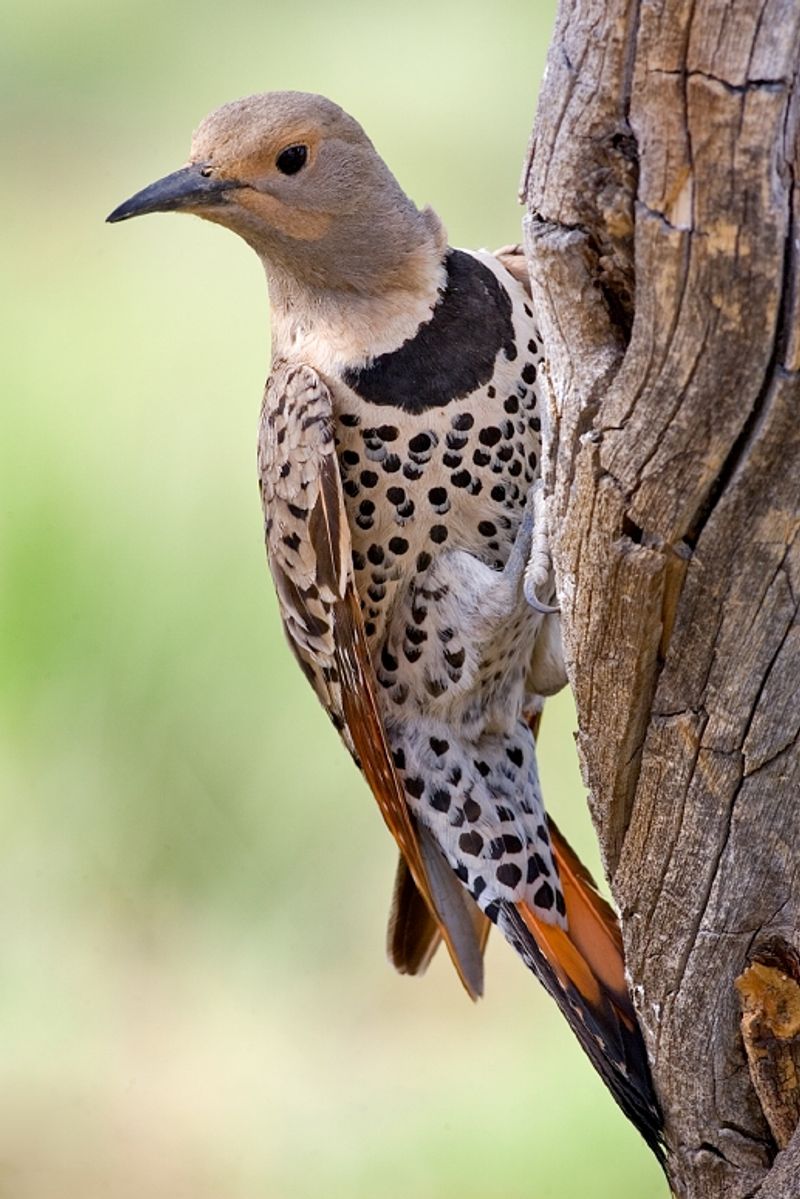
The northern flicker or common flicker is a type of bird that belongs to the woodpecker family. It is native to much of North America, as well as parts of Central America, Cuba, and the Cayman Islands.
It is one of the few woodpecker species that engage in seasonal migration, making seasonal trips in order to find food or a suitable place to breed. Northern flickers have a long, curved beak that helps them to feed on insects, fruits, and seeds.
They are typically brownish-gray in color, with black and white markings on their wings and tail feathers. They are also known for their loud, distinctive call, which is often heard in wooded areas. Northern flickers are most commonly found in open woodlands, parks, and gardens.
They build nests in tree cavities and often use abandoned nests of other species.
They can live up to 12 years in the wild if they are able to avoid predators. In the United States, the northern flicker is listed as a species of least concern on the IUCN Red List of Threatened Species.
However, their population is declining due to the loss of suitable habitat and due to competition with invasive species. As such, it is important to conserve their habitats and ensure that they have enough food and suitable nesting sites.
| Kingdom | Animalia |
| Phylum | Chordata |
| Class | Aves |
| Order | Piciformes |
| Family | Picidae |
| Genus | Colaptes |
| Species | C. auratus |
5. Acorn Woodpecker
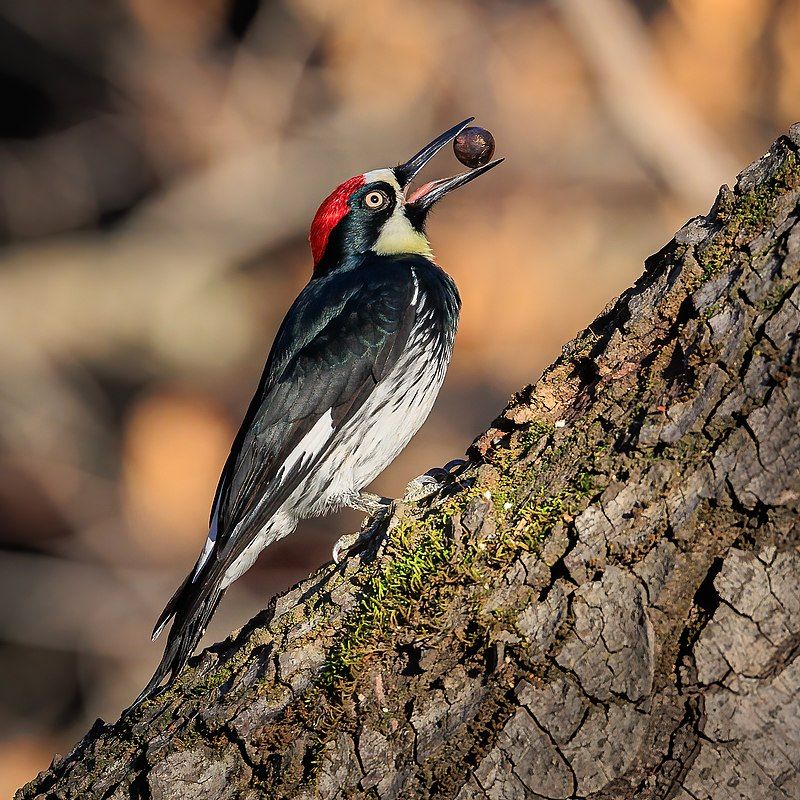
The acorn woodpecker is an interesting species of bird. It is classified as a medium-sized woodpecker, measuring approximately 21 cm in length and weighing an average of 85 g. The acorn woodpecker is typically black and white with a red crown, making it easily recognizable.
Its diet mainly consists of acorns, insects, and occasionally berries and other fruits. It is a cavity-nesting species, meaning that it builds nests in existing cavities or hollows in trees.
This species is found primarily in western North America, from southwestern British Columbia south to northern Nicaragua.
Acorn woodpeckers are known for their unique behavior, which includes cooperative breeding, where multiple birds share the same nest and help care for their young.
It is also known for its granary tree, which is a storage tree where the birds put their acorns for later consumption.
| Kingdom | Animalia |
| Phylum | Chordata |
| Class | Aves |
| Order | Piciformes |
| Family | Picidae |
| Genus | Melanerpes |
| Species | M. formicivorus |
6. Killdeer
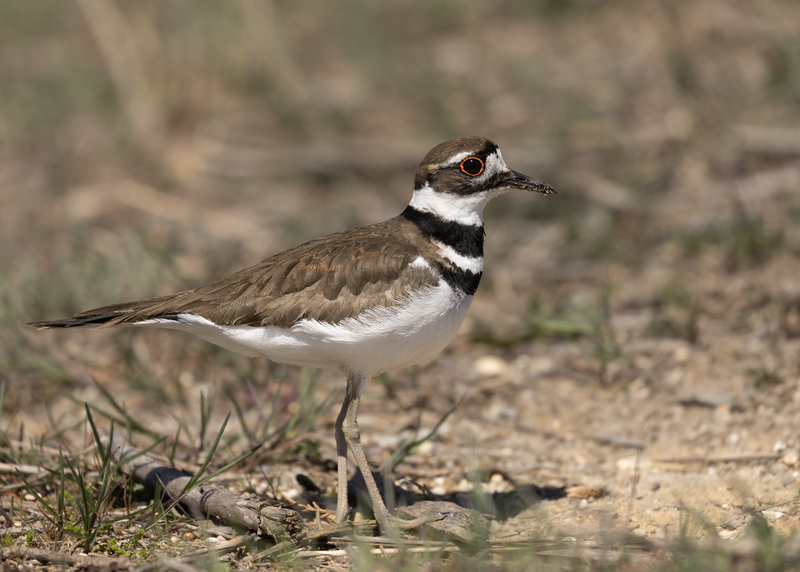
The Killdeer is a type of bird found in the Americas. It belongs to the plover family and is relatively large in size. It is named after its two-syllable call which is very distinctive and often heard.
Its scientific name was given by Carl Linnaeus in 1758 in the 10th edition of his Systema Naturae. Currently, three subspecies of the killdeer have been identified. They are distinguished by their physical characteristics such as size, coloration, and habitat preferences.
Each of these subspecies has adapted to live and thrive in different environments. The Killdeer is a fascinating bird that has adapted to a wide variety of habitats and is an important part of the ecosystem.
| Kingdom | Animalia |
| Phylum | Chordata |
| Class | Aves |
| Order | Charadriiformes |
| Family | Charadriidae |
| Genus | Charadrius |
| Species | C. vociferous |
7. Brown creeper
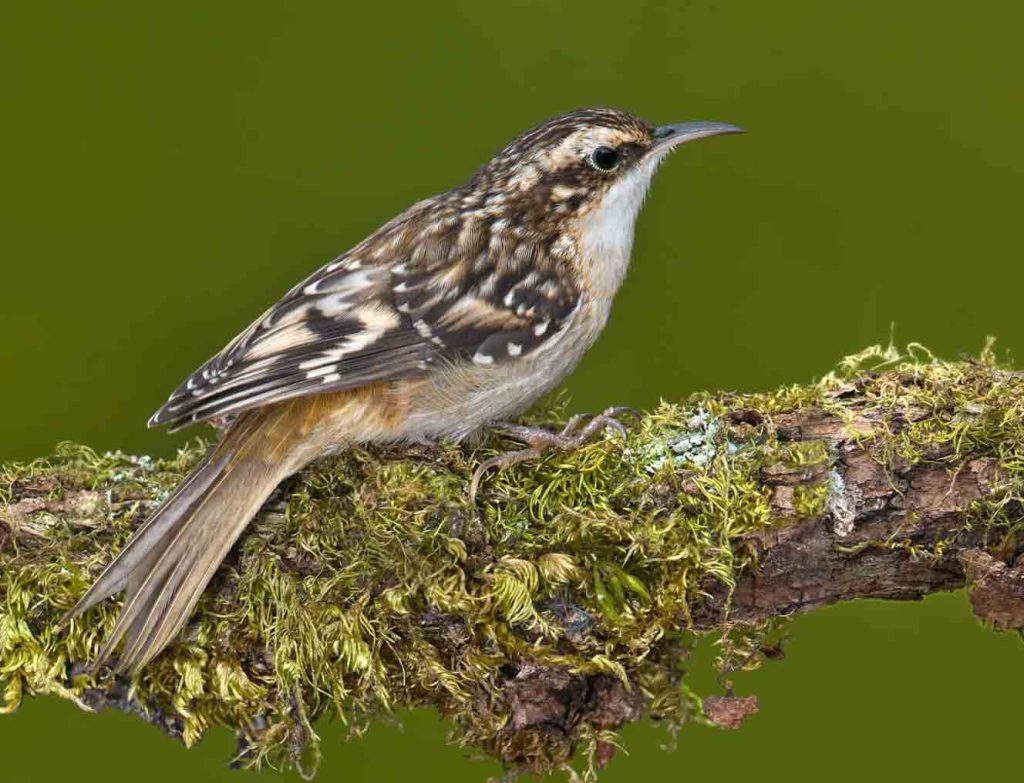
Source: nationalgeographic.com
The brown creeper, also known as the American treecreeper, is a small songbird native to North America. It has a brown body with darker brown streaks on its wings and tail. Its long, curved beak is perfectly adapted to probe for food in tree crevices.
It also has a white underside with white stripes on its wings. It is the only North American member of the treecreeper family Certhiidae. The brown creeper’s diet consists mainly of insects and spiders, which it finds by probing tree bark and trunks with its long beak.
It has a unique way of foraging. It starts at the base of a tree, working its way up in a spiral pattern, often flying up to the next tree branch before spiraling back down.
This behavior allows it to cover more ground in search of food. In addition to foraging for food, the brown creeper also builds its nest from strips of tree bark and other material. The nest is usually located in a tree cavity or between two branches.
The female lays three to seven eggs, which are incubated by both parents.
The chicks hatch after about two weeks and are fed by their parents for about a month before they are ready to leave the nest.The brown creeper is a shy bird and can often be heard singing from the treetops.
Its song is a series of high-pitched notes that echo through the forest. This species is considered to be of least concern and is not currently threatened by habitat loss or other human activities.
| Kingdom | Animalia |
| Phylum | Chordata |
| Class | Aves |
| Order | Passeriformes |
| Family | Certhiidae |
| Genus | Certhia |
| Species | C. americana |
8. Mountain Chickadee
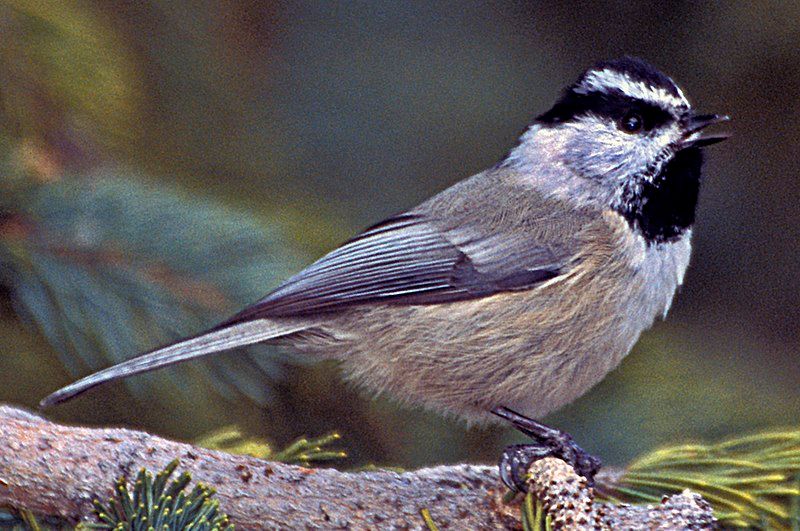
The mountain chickadee is a small, attractive bird that is part of the songbird family. It is a passerine, which is a type of bird that is characterized by its perching and walking behavior.
The mountain chickadee belongs to the tit family, Paridae, which is a large family of small to medium-sized passerine birds found in the Northern Hemisphere and parts of Africa. This family includes tits, chickadees, titmice, and verdins.
The mountain chickadee is a grayish-brown bird with a white belly and a black cap on its head. Its wings and tail feathers are also black, and it has a long, thin bill. It is highly active and can often be heard singing its melodious song.
This songbird typically lives in coniferous forests, mountain forests, and shrublands in the western United States and parts of Canada.
The mountain chickadee is an important part of the local ecosystem as it feeds on insects and seeds, and its nesting activity helps disperse seeds and provide food for other animals.
Its presence is also important in controlling insect populations, making it a valuable member of the local environment.
| Kingdom | Animalia |
| Phylum | Chordata |
| Class | Aves |
| Order | Passeriformes |
| Family | Paridae |
| Genus | Poecile |
| Species | P. gambeli |
9. Dark-eyed Junco
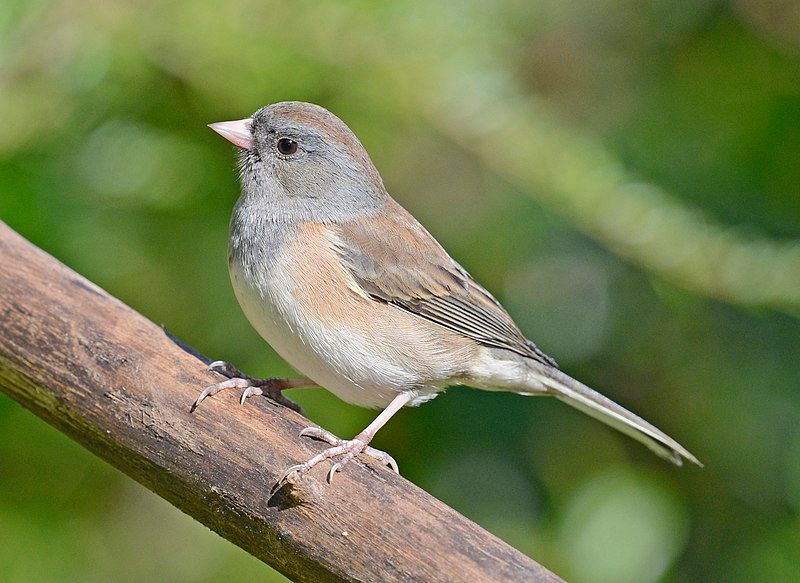
The dark-eyed junco is a type of small sparrow that is native to North America and parts of the Arctic. It has a grayish color and is commonly seen across much of temperate North America.
This sparrow is closely related to the fox sparrow, and it is quite variable in its characteristics.
Despite this, scientists have not yet been able to fully understand the different varieties of the dark-eyed junco and the complexities of its relationships with other sparrow species.
This bird is a very adaptable species, and its range extends far into the Arctic during the summer months. The dark-eyed junco has a unique place in the bird world, and its scientific research is ongoing.
| Kingdom | Animalia |
| Phylum | Chordata |
| Class | Aves |
| Order | Passeriformes |
| Family | Passerellidae |
| Genus | Junco |
| Species | J. hyemalis |
10. Long-tailed Tit
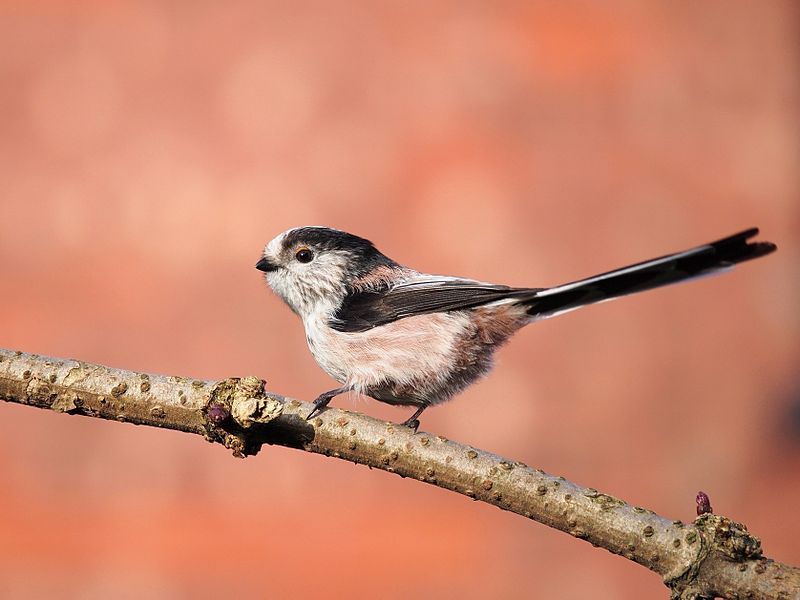
The long-tailed tit is a small bird species that is found in many parts of Europe and the Palearctic. It is also known as the long-tailed bushtit, and it is a common bird in these regions.
The scientific name of this bird species is Aegithalos, which was a term used by Aristotle in the past to refer to some European tit species, including the long-tailed tit. The long-tailed tit is a small bird with a long tail and a white head with black markings.
Its body is mostly gray, and it has a black-and-white striped back. It has short feet and a short beak. The wingspan of this species is about five inches, and its length is between three and four inches. This species is active during the day, and it feeds mainly on small insects.
It also feeds on seeds, berries, and other small fruits. It is often seen in small flocks, and it makes a variety of vocalizations. It is also known to migrate in the colder months. The long-tailed tit is a common bird species that is widespread in Europe and the Palearctic.
Its scientific name, Aegithalos, is a term used by Aristotle to refer to some European tit species, including the long-tailed tit. This species is small in size with a long tail and a white head with black markings.
It feeds mainly on small insects and other small fruits, and it is often seen in small flocks. It is an active bird during the day, and it migrates in the colder months.
| Kingdom | Animalia |
| Phylum | Chordata |
| Class | Aves |
| Order | Passeriformes |
| Family | Aegithalidae |
| Genus | Aegithalos |
| Species | A. caudatus |
11. Steller’s Jay
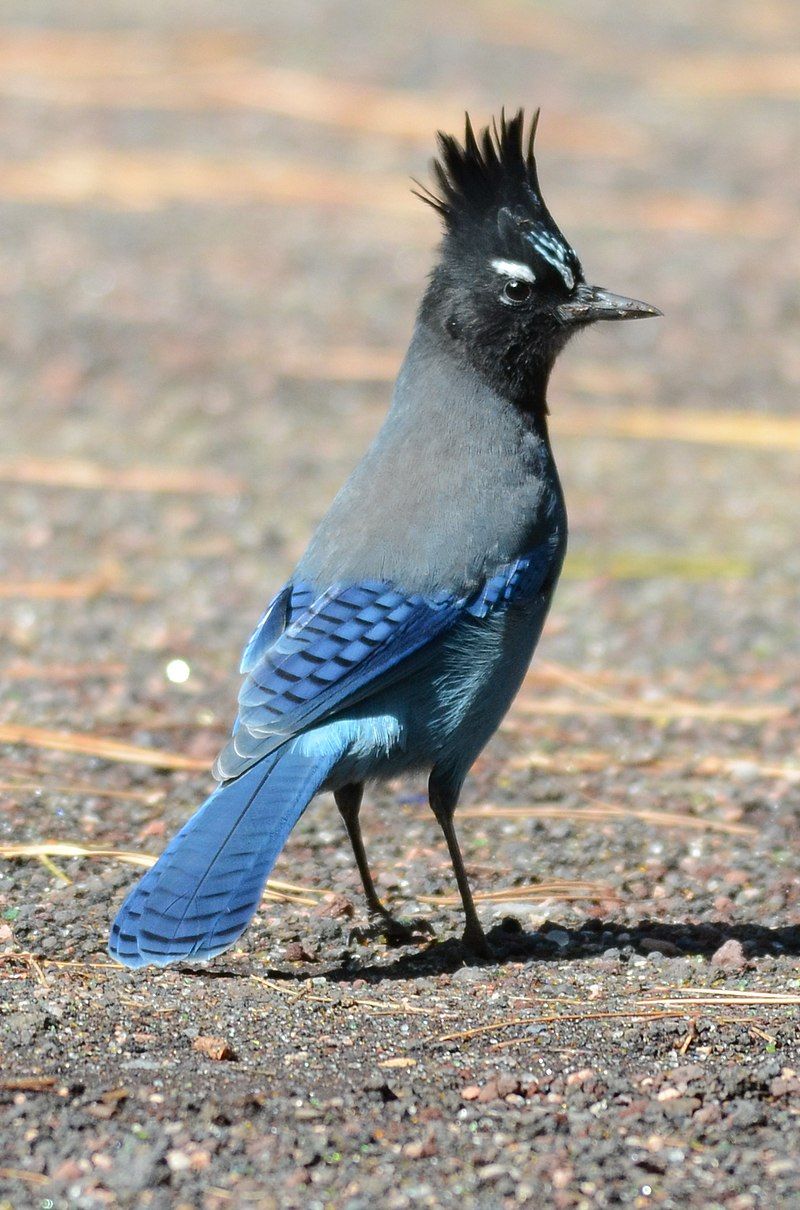
Steller’s jay is a beautiful and distinctive bird found in western North America and the mountains of Central America. It is a member of the crow family and is closely related to the blue jay found in eastern North America.
Steller’s jay stands out from other birds in its family because of its prominent crest on its head, making it the only crested jay west of the Rocky Mountains. The Steller’s jay is known for its gorgeous blue and black plumage, with a bright white forehead and a black crown.
Its tail feathers are a deep blue, and its wings are a lighter blue and black. This bird is also known for its distinctive call, which is loud and harsh. It’s not surprising to hear a Steller’s jay shrieking from the treetops, as this is their preferred habitat.
Although they are found in both western and Central America, the Steller’s jay has adapted to a variety of habitats, from wooded areas to open meadows. They are omnivores, eating a wide range of food, including fruits, nuts, seeds, insects, and even eggs and small animals.
They are also known to scavenge for food in bird feeders and campsites. The Steller’s jay is a charismatic and impressive creature, and its presence in the western United States and Central America is both a blessing and a privilege.
Its beautiful plumage and loud call make it a unique addition to any environment.
| Kingdom | Animalia |
| Phylum | Chordata |
| Class | Aves |
| Order | Passeriformes |
| Family | Corvidae |
| Genus | Cyanocitta |
| Species | C. stelleri |
12. Mallard
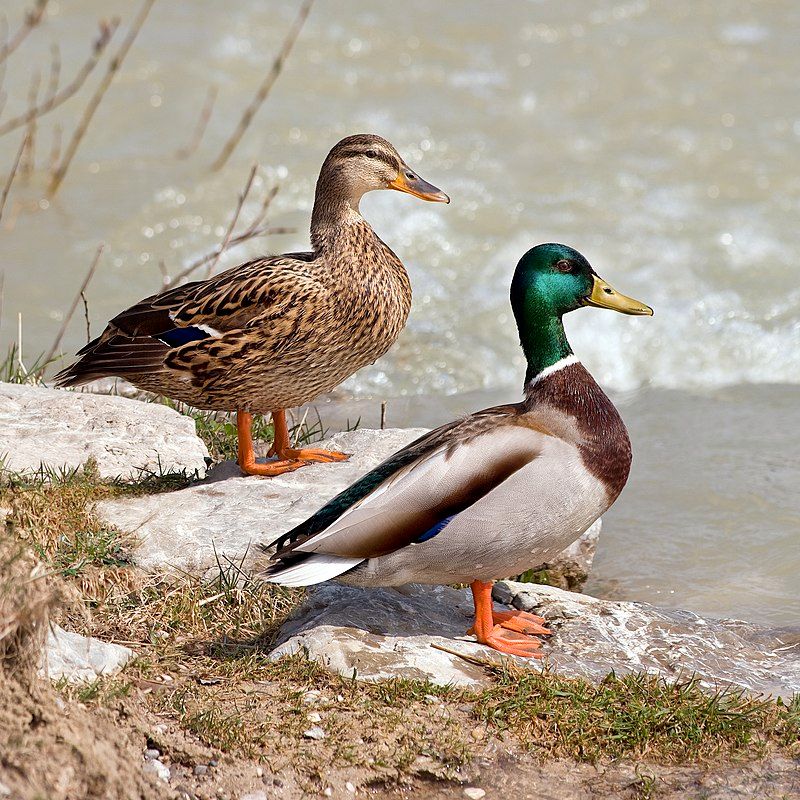
The mallard, also known as the wild duck, is a species of dabbling duck that is found around the world in many different regions. It is native to the temperate and subtropical areas of the Americas, Eurasia, and North Africa.
In addition, it has been introduced to many other countries, including New Zealand, Australia, Peru, Brazil, Uruguay, Argentina, Chile, Colombia, the Falkland Islands, and South Africa. Mallards are a type of waterfowl that are highly adaptable and can be found in a variety of habitats, from marshes and lakes to urban parks and gardens.
They are omnivorous, feeding on both plant matter and small animals like insects, snails, and fish. Mallards are strong flyers and are often seen traveling in small flocks. The mallard is also a popular species for hunting, due to its large size and abundant population.
Mallards are also important to the global waterfowl population and are considered a keystone species in many areas. They also play an important role in the local ecology by providing food for other animals and helping to spread seeds and other plant matter.
| Kingdom | Animalia |
| Phylum | Chordata |
| Class | Aves |
| Order | Anseriformes |
| Family | Anatidae |
| Genus | Anas |
| Species | A. platyrhynchos |
13. White-faced Ibis
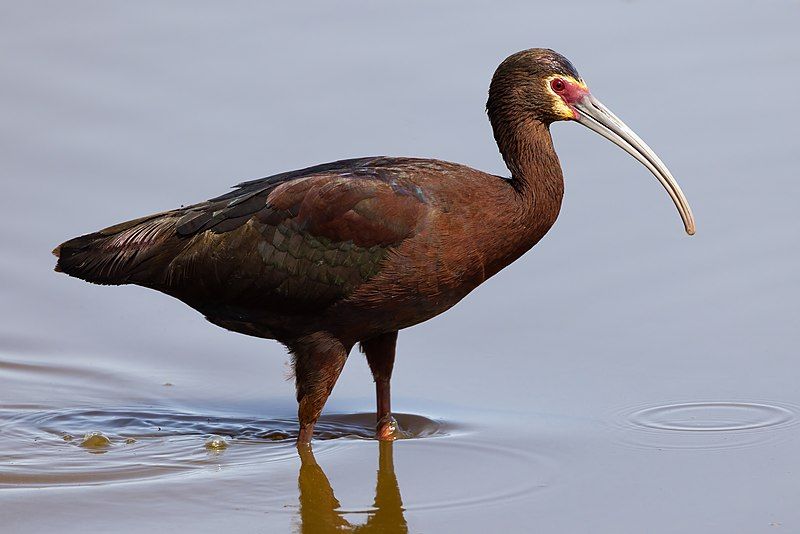
The white-faced ibis is a majestic bird belonging to the ibis family of the Threskiornithidae group. It is a wading bird that can be found in wetlands, marshes, and other marshy areas. This species usually breeds in colonies, building nests in bushes or low trees.
The white-faced ibis is easily recognizable by its white face and long, curved bill. It has a blackish-brown body with a glossy green sheen. Its long wings and legs enable the bird to wade through shallow waters to hunt for food.
In addition, the white-faced ibis is known for its graceful courtship displays that involve a number of postures and movements. These displays are often performed in pairs as part of the mating ritual.
The white-faced ibis is an important part of the wetland ecosystem and is an important indicator species for the health of wetlands.
| Kingdom | Animalia |
| Phylum | Chordata |
| Class | Aves |
| Order | Pelecaniformes |
| Family | Threskiornithidae |
| Genus | Plegadis |
| Species | P. chihi |
14. Common Raven
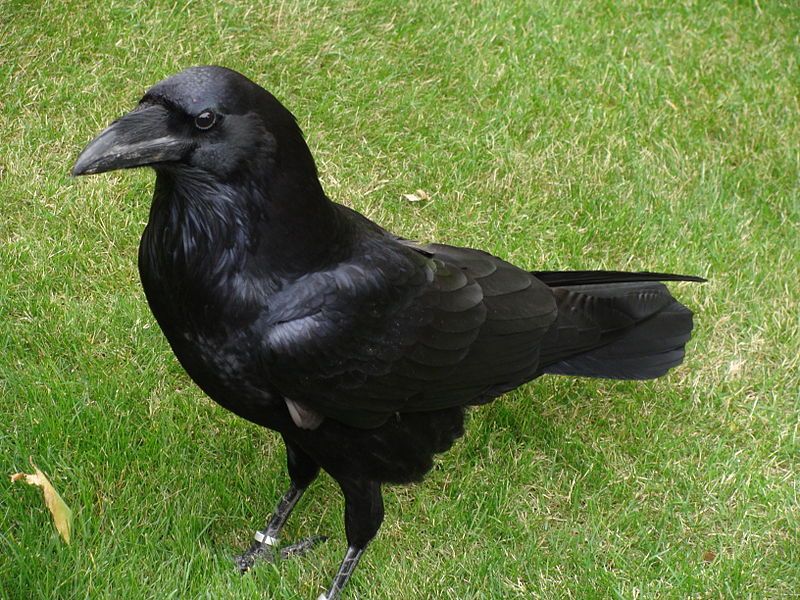
The common raven is a large, black bird that belongs to the family of passerine birds. It is a member of the corvid family, which includes crows, magpies, and jays.
The common raven is widely distributed across the Northern Hemisphere, spanning from western Europe to North America, and even as far east as Japan. It can be found in a variety of habitats, including forests, mountains, grasslands, and tundra.
The common raven is an omnivorous species, meaning it feeds on a variety of food sources, including carrion, small rodents, insects, and even fruit.
Its diet is quite variable, and it is also known to scavenge for food, often taking advantage of resources left by other animals. The common raven is well-known for its intelligence and has been observed to display a wide range of behaviors, including tool use.
It is also known for its vocalizations, which vary between different individuals and populations.
They are capable of producing a wide variety of sounds, from loud croaks to high-pitched whistles. The common raven is a solitary species, and pairs will only form during the breeding season.
During this time, the birds will build large nests in trees or on cliffs, and the female will lay up to seven eggs. The young will stay with their parents for several months before they disperse and become independent.
| Kingdom | Animalia |
| Phylum | Chordata |
| Class | Aves |
| Order | Passeriformes |
| Family | Corvidae |
| Genus | Corvus |
| Species | C. corax |
15. Woodpeckers
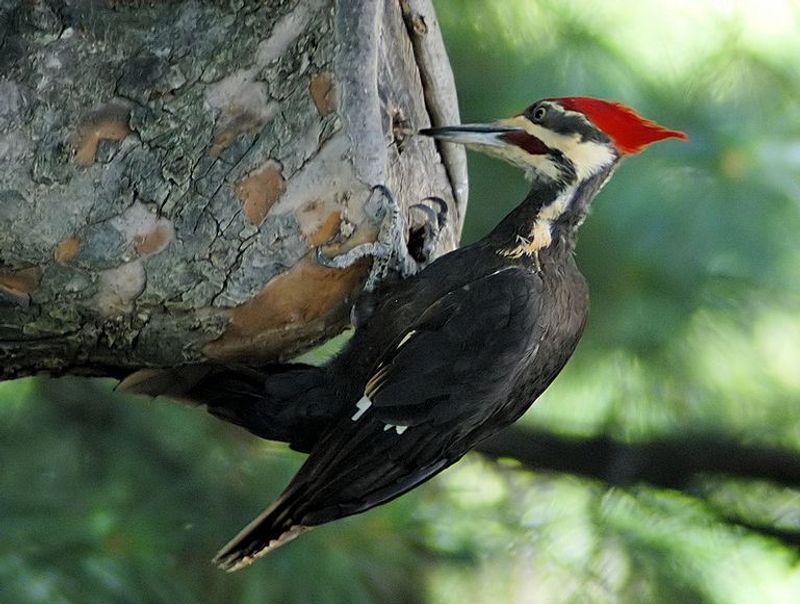
The family Picidae is a family of birds that includes woodpeckers, piculets, wrynecks, and sapsuckers. They are found all over the world, with the only exceptions being Australia, New Guinea, New Zealand, Madagascar, and the extreme polar regions.
Woodpeckers are the most widespread and recognizable members of the Picidae family. They have a distinctive appearance, with a large, pointed beak and a strong neck. They use their beaks to hammer on trees and other hard surfaces in order to find food and make nests.
Woodpeckers also have special stiff tail feathers that help support them against tree trunks as they climb and search for food. Piculets are small, colorful birds that are related to woodpeckers. They are found in forests and woodlands throughout the Americas and Asia.
Piculets are similar in size to wrens, but their beaks are longer and straighter than those of wrens. They use their beaks to probe bark and foliage for insects and other small invertebrates. Wrynecks are slender, brownish birds that are related to woodpeckers.
They are found mainly in Europe, Africa, and Asia. Wrynecks have a distinctive pattern of black and white stripes on their backs, which helps them blend in with tree bark and avoid predators.
They use their long, pointed beaks to feed on small insects that live in tree bark, and they sometimes climb up tree trunks to feed. Sapsuckers are large woodpeckers that are found in North and South America.
They have a distinctive black-and-white pattern on their backs, and a long, curved beak. They use their beaks to drill holes in trees and feed on the sap that oozes from the holes. Sapsuckers also eat insects and berries, and they sometimes visit bird feeders to look for food.
In conclusion, the Picidae family is a diverse family of birds that includes woodpeckers, piculets, wrynecks, and sapsuckers. These birds are found all over the world, except for Australia, New Guinea, New Zealand, Madagascar, and the extreme polar regions.
Each of these birds has a unique appearance and behavior that helps them survive in their environment.
| Kingdom | Animalia |
| Phylum | Chordata |
| Class | Aves |
| Order | Piciformes |
| Family | Picidae |
16. Swallows
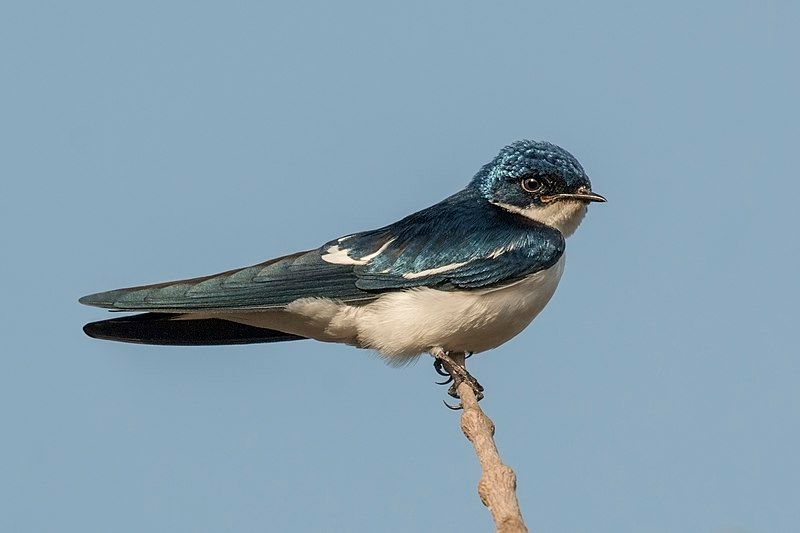
The Hirundinidae family is composed of three distinct bird species, the swallow, the martin, and the saw-wing. They are passerine birds, which means they have a strong, melodic song. These birds can be found on every continent, even Antarctica.
They are highly adapted to aerial feeding, which involves catching insects in mid-air. This adaptation has given them a distinctive look, with streamlined bodies and long wings that help them maneuver easily in the air.
The swallow, for example, has a pointed tail and long, pointed wings that help it to make sharp turns and dive for prey. The martin has a short, square tail and broad wings that allow it to hover in one spot while feeding.
The saw-wing has a longer, more curved tail and longer wings that help it to soar and swoop gracefully. All three species are able to catch their prey quickly, which is key to their success.
| Kingdom | Animalia |
| Phylum | Chordata |
| Class | Aves |
| Order | Passeriformes |
| Family | Hirundinidae |
17. Blue-gray Gnatcatcher
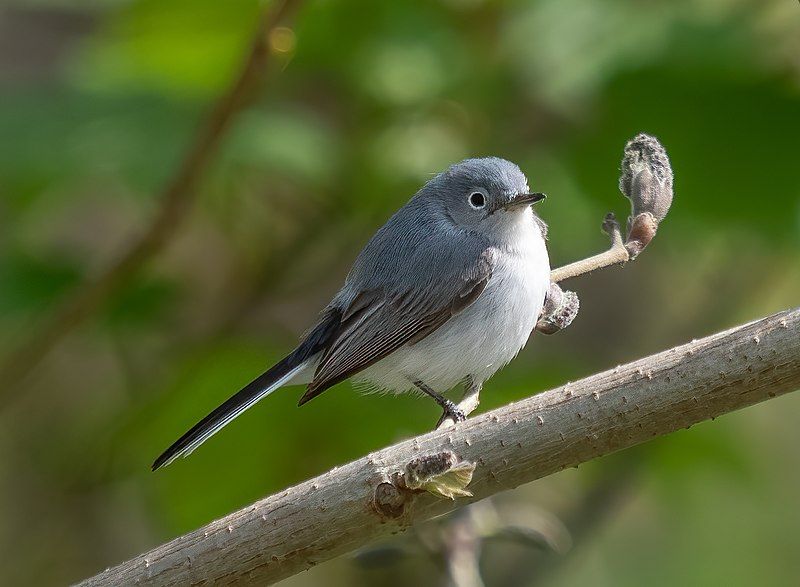
The blue-gray gnatcatcher is a small songbird native to North America. It is a member of the family Polioptilidae and is most easily identified by its grayish-blue upperparts, white underparts, and a distinctive white eye ring.
The bird is also known for its long, thin bill and its habit of hovering above the ground to catch insects. It is found in deciduous forests and shrubby habitats, and can often be heard singing its simple, unobtrusive song.
During the breeding season, it builds a cup-shaped nest in a shrub or tree, usually close to the ground. It feeds primarily on flying insects, such as moths, beetles, and flies.
The blue-gray gnatcatcher is an adaptive species, which means that it can survive in a wide variety of habitats. It is a common bird throughout most of its range, although its population has declined somewhat in recent years due to habitat loss and degradation.
| Kingdom | Animalia |
| Phylum | Chordata |
| Class | Aves |
| Order | Passeriformes |
| Family | Polioptilidae |
| Genus | Polioptila |
| Species | P. caerulea |
18. Yellow-rumped Warbler
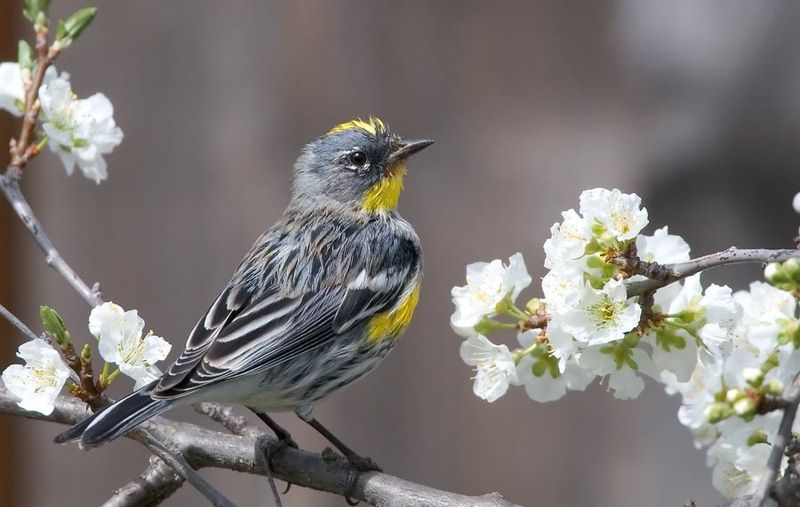
The yellow-rumped warbler is a species of bird that is native to North America and is found throughout the continent. It is a small bird, typically measuring in at around five and a half inches in length, with a wingspan of around seven inches.
It is easily identifiable by its bright yellow throat patch and rump, as well as the white and black streaks on its wings and back.
They are also known as “myrtle warblers” due to the myrtle-colored feathers on their heads. The yellow-rumped warbler is a migratory species, typically breeding in the northern parts of North America during the summer months and migrating south during the winter.
They feed on insects, fruits, and berries, and can often be seen foraging among bushes and trees.
They have also been known to eat nectar from flowers, making them a beneficial species for gardeners. The yellow-rumped warbler is a regular sight in North America and can be observed in many different habitats, from forests and woodlands to grasslands, marshlands, and even gardens.
They are common in most parts of the continent and can be found in both urban and rural areas. With their cheerful songs and bright colors, they are a welcome sight for bird watchers and nature enthusiasts alike.
| Kingdom | Animalia |
| Phylum | Chordata |
| Class | Aves |
| Order | Passeriformes |
| Family | Parulidae |
| Genus | Setophaga |
| Species | S. coronata |
19. Western Bluebird
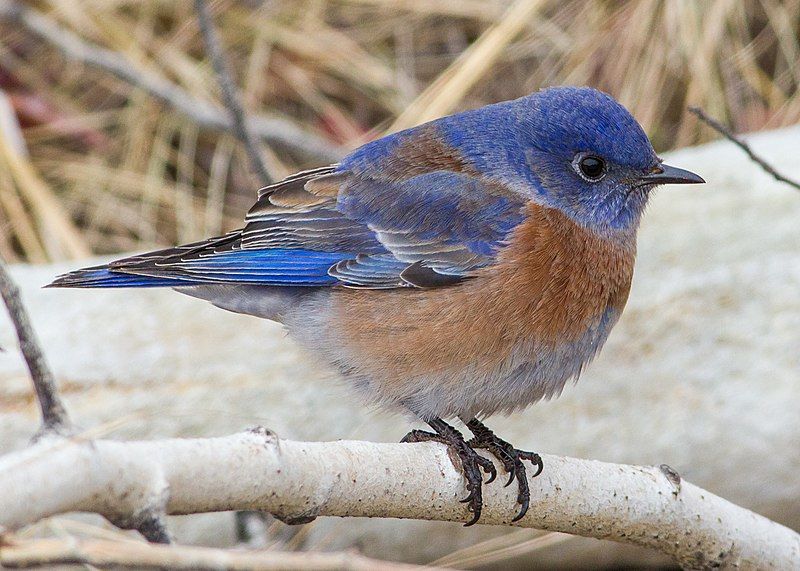
The western bluebird is a member of the thrush family and is native to North America. It is a small bird, usually ranging from 15 to 16 cm in length and weighing around 20 to 30 grams. The western bluebird has a blue back, wings, and tail with a rusty red breast and belly.
Its wings are short and rounded and its tail is slightly forked. Its beak is thin and pointed, which it uses to feed on insects, berries, and other small fruits.
The western bluebird can be found in open woodlands, grasslands, and meadows in western North America, from Canada to Mexico. In the United States, it is most commonly found in the western states, stretching from the Rocky Mountains to the Pacific coast.
It is also found in parts of Mexico, as well as parts of Guatemala, El Salvador, and Honduras. The western bluebird is an important species in its ecosystem, as it is a major contributor to seed dispersal and insect control.
It also plays an important role in the food chain, as its diet consists of a variety of insects, berries, and fruits. The western bluebird is also an important indicator species, as its presence in an area can be an indicator of the overall health of the environment.
Overall, the western bluebird is an important species in its ecosystem, and its presence is an indication of a healthy environment. It’s small size and beautiful plumage also make it a popular sight for bird watchers and nature enthusiasts alike.
| Kingdom | Animalia |
| Phylum | Chordata |
| Class | Aves |
| Order | Passeriformes |
| Family | Turdidae |
| Genus | Sialia |
| Species | S. mexicana |
20. Ruby-crowned Kinglet
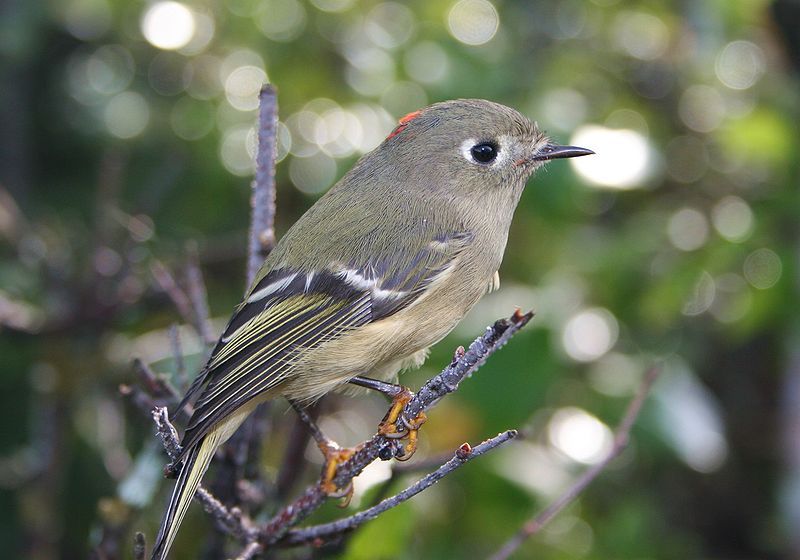
The ruby-crowned kinglet is a tiny bird belonging to the kinglet family, found all over North America. It has a unique plumage of greenish-olive color, with two white wing bars and a white eye ring.
The most distinctive feature of this bird is the red crown patch on the males, which is usually hidden from view. The small size of the ruby-crowned kinglet makes it difficult to spot in the wild, but it can be identified by its call, which is a loud, high-pitched “tsip” noise.
This bird is insectivorous, and its diet consists mainly of small invertebrates such as spiders, beetles, and caterpillars. During the breeding season, it builds its nest in trees and shrubs, usually in the middle or near the top.
The female lays four to six eggs, which both parents take turns incubating. Once the chicks hatch, the parents feed them and care for them until they are able to fly.
The ruby-crowned kinglet is an important part of the North American ecosystem, as it helps to control insect populations. It is also an attractive and interesting bird to watch, and its presence is often welcomed by birdwatchers.
| Kingdom | Animalia |
| Phylum | Chordata |
| Class | Aves |
| Order | Passeriformes |
| Family | Regulidae |
| Genus | Corthylio |
| Species | C. calendula |
Conclusion
Oakhurst is a great place to observe and study birds. The diverse habitats in the area provide a great home for a wide variety of bird species, from the common backyard birds to the rare species.
With a variety of habitats and plenty of food sources, Oakhurst is a great place for both birdwatchers and birders to enjoy the beauty of nature.